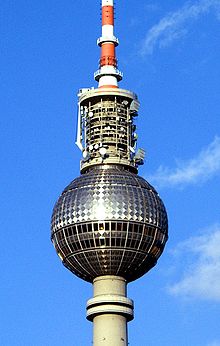Fernsehturm Berlin

The Fernsehturm (German for "television tower") is a television tower in the city centre of Berlin, Germany. It is a well-known landmark, close to Alexanderplatz. The tower was built between 1965 and 1969 by the former German Democratic Republic (GDR) and its image was used as a symbol of Berlin by the GDR administration. The tower is easily visible throughout central and some surburban districts of Berlin and remains a symbol of the city.
The original total height of the tower was 365 metres, but after the installation of a new antenna in the 1990s, the height is now 368 m. The Fernsehturm is the fourth tallest freestanding structure in Europe, after Moscow's Ostankino Tower, the Kiev TV Tower and the Riga Radio and TV Tower. There is a visitor platform and a rotating restaurant in the middle of the sphere. The visitor platform is at a height of about 204 m above the ground and visibility can reach 42 km (25 miles) on a clear day. The restaurant, which rotates once every twenty minutes, is a few metres above the visitors platform (originally it turned once per hour; the speed was later doubled, and tripled following the tower's late 1990s renovation).
Inside the shaft are two lifts for bringing visitors into the sphere section of the tower within 40 seconds. It is not accessible by wheelchair. Due to their small size, there are long waits at the base of the tower.
To mark the 2006 FIFA World Cup in Germany, and the final match in Berlin Olympic Stadium, the sphere was decorated as a football with magenta-coloured pentagons, which was the corporate colour of World Cup sponsor Deutsche Telekom, the owner of the tower.
History


In 1964, Walter Ulbricht, leader of the Socialist Unity Party which governed East Germany, decided to allow the construction of a television tower on Alexanderplatz. The Berliner Fernsehturm was modelled on the Fernsehturm Stuttgart. The architecture traces back to an idea from Hermann Henselmann and Jörg Streitparth. Walter Herzong and Herbert Aust later also took part in the planning. Construction began on 4 August 1965. After 4 years of construction, the Fernsehturm began test broadcasts on 3 October 1969, and was officially inaugurated four days later on the GDR's National Day. It is among the best known sights in Berlin, and has around a million visitors every year. It has been likened to a stalk of asparagus (East Berlin journalists sometimes referred to it as the Telespargel, "tele-asparagus") and the Death Star from Star Wars.
Although building this tower had begun on a television tower in southeast Berlin's Müggelberg, the project was stopped, because a tower in that location would have been dangerous to planes entering and leaving nearby Schönefeld International Airport.
The "Pope's Revenge"

When the sun shines on the Fernsehturm's tiled stainless steel dome, the reflection usually appears in the form of a cross. This effect was neither predicted nor desired by the planners. As a jibe against the atheist foundations of the Communist government, and the ongoing suppression of church institutions in East Germany, Berliners immediately named the luminous cross Rache des Papstes, or "Pope's Revenge". For the same reasons, the structure was also called "St. Walter" (from Walter Ulbricht).
U.S. President Ronald Reagan mentioned this phenomenon in his "Tear down this wall" speech on 12 June 1987:
- "Years ago, before the East Germans began rebuilding their churches, they erected a secular structure: the television tower at Alexanderplatz. Virtually ever since, the authorities have been working to correct what they view as the tower's one major flaw: treating the glass sphere at the top with paints and chemicals of every kind. Yet even today when the sun strikes that sphere, that sphere that towers over all Berlin, the light makes the sign of the cross. There in Berlin, like the city itself, symbols of love, symbols of worship, cannot be suppressed."
Popular culture
In the BBC film, End Day, the tower is destroyed. In the film Tornado, the windows of the tower are destroyed by a tornado.
Technical Details

- Entrance of observation deck is 6.25 metres above ground
- 2 lifts to transport the visitors
- 1 lift to transport technical equipment
- Steel stairway with 986 steps
- Evacuation platforms at 188 metres and 191 metres heights
- Observation deck at 203.78 metres
- Restaurant at 207.53 metres
- Height of the tower: 368.03 metres
- Weight of the shaft: 26 000 tonnes
- Weight of the sphere 4 800 tonnes
See also
External links
- Berlin Television Tower at Structurae
- Satellite view of Fernsehturm at WikiMapia
- Fernsehturm Official Website
- Satellite photo of the Fernsehturm on Google Maps
- 360°Panorama Fernsehtum during the Festival of Lights
- Berliner Fernsehturm during Football Worldcup 06
- All about the tower and Panorama
Template:Supertall observation and communication towers 52°31′15″N 13°24′34″E / 52.52083°N 13.40944°E
